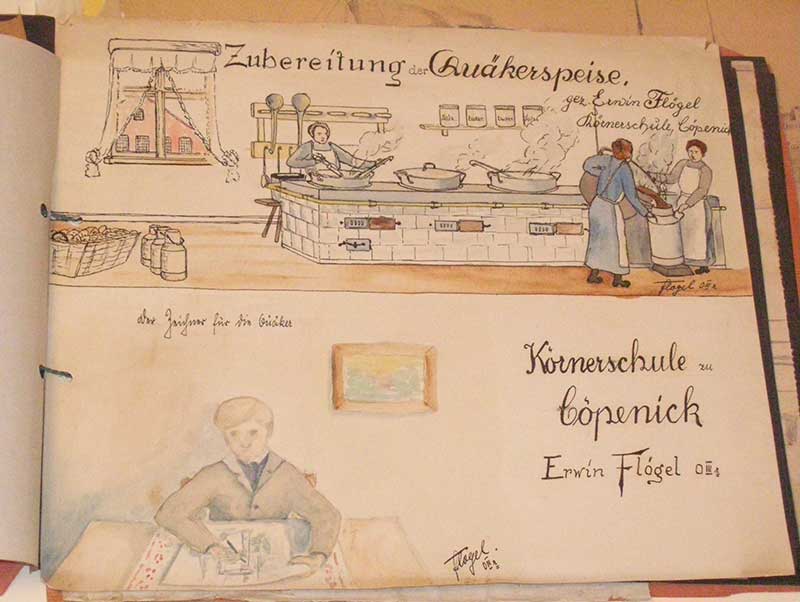A boy’s watercolor depicts a heartwarming scene created amid the misery and starvation of post-World War I Germany. The painting, part of a new exhibit entitled “Giving Voices to Ghosts,” shows three women busy preparing food. Steam and presumably pleasant aromas arise from large kettles. Small containers of salz (salt) and zucker (sugar) sit nearby. The lower half of the painting, an apparent self-portrait, is of the boy with neatly parted blond hair sitting at a desk drawing.

“I wonder what became of this talented artist,” asked Nichole Mathews, an Indianapolis-area high school German teacher who helped create the exhibit. “Did he survive the coming war?”
The question, like the exhibit, is haunting yet hopeful. “Giving Voices to Ghosts” is made up artwork and poems created in the 1920s by children (all over Germany including an orphanage in Kopenick, Germany, as well as schools in Trier) who were among the millions in Europe—primarily in Germany and Austria—fed by Quaker-led relief efforts after World War I. The children’s artwork was given to Friends more than 90 years ago as a show of gratitude for the food—sometimes just 600 calories a day—that kept them hopeful and alive in their time of need.
The exhibit debuted last year at Marian University in Indianapolis, Ind., and later was displayed at Indianapolis First Friends Meeting, where it originated. Now Mathews is hoping others will be interested in these generations-old drawings, poems, and documents. The goal is to examine how the love and gratitude of children can provide guidance and courage in today’s divided world.
“Sometimes we get stuck in a holding pattern with our faith or lives. This has helped shake me out of it and has made me a better Quaker,” Mathews said. “I got to learn about these amazing Friends and what they had to overcome to do what God had put them there to do: Facing public shame and censor for helping an enemy and putting themselves in harm’s way to help strangers. That is very powerful and a daunting legacy to fill to be the best Friend you can be in this day and age.”
The post-World War I relief effort was Quakerspeisung, or Quaker feeding, overseen by American Friends Service Committee (AFSC) and its British counterpart. In 1919, Herbert Hoover asked AFSC to lead a massive feeding program in Germany. Within four years, the program was feeding about 500,000 children per day, ultimately impacting one million. History tells us devastation would soon come again with World War II, yet the bond of service and gratitude between the German children and the Quaker and non-Quaker relief workers was real.
The children sent materials as “thank-yous” to various Quaker meetings. Mathews said the portfolio came to Indianapolis First Friends with a group about 20 years ago that did a presentation about AFSC. The art portfolio was largely forgotten for years.
Mathews, a German teacher attending First Friends, was given the artwork more than a decade ago by Jennie Banker, wife of Stan Banker, then pastor of Indianapolis First Friends Meeting. Mathews was not raised a Quaker. She started church hopping after moving to Indianapolis from Ohio in 2002, eventually drawn to the Quakers because of the group’s history of strong female leaders and emphasis on seeing the Divine (the Inner Light) in all people.
Several years after receiving the artwork, Mathews attempted to photograph the roughly 70 drawings, poems, letters, telegrams, and other documents in the folder.
The assembling of the exhibit became a team effort as Mathews connected with those outside of her Quaker community who wanted to contribute to the project.
She met Jenny Ambroise, director of the Marian University art gallery through a mutual friend. Mathews felt a kinship between the peace testimony of Quakers and Marian’s Catholic Franciscan emphasis on peace and justice. Ambroise put her in touch with Bill Foley, a Pulitzer-prize winning photojournalism and assistant professor at Marian. His students took high-quality photographs of the collection. Mathews’s German students at Hamilton Southeastern High School near Indianapolis along with Marian students worked on the translations. A grant from the Talbot Street Art Fair in Indianapolis provided funds to frame 33 documents and drawings. Crystal Vicars-Pugh, assistant professor of art and gallery director at Marian, helped set up the final exhibit at the school’s art gallery.
That exhibit allows these once waif-like victims of war to speak their message to our generation—thus the title.
“‘Giving Voices to Ghosts’ was an educational experience for those involved in creating the exhibition and for those who visited the gallery to view the ‘thank you’ paintings and drawings created so many years ago,” Vicars-Pugh said. “The images are filled with kind words and visual acts of thankfulness for food.”
One drawing shows a pot boiling with nourishment. The translated poem below reads:
Quaker Food is still quite warm!!
In warmer love Offered
Received with warmer gratitude . . .
For our nation and world today, Mathews sees the translation as this: “There is hope even in the darkest places. We have the ability to make a difference far more than we ever can imagine. There is still hunger and a need for Friends to be a nonjudgmental bridge between groups and peoples.”




Comments on Friendsjournal.org may be used in the Forum of the print magazine and may be edited for length and clarity.